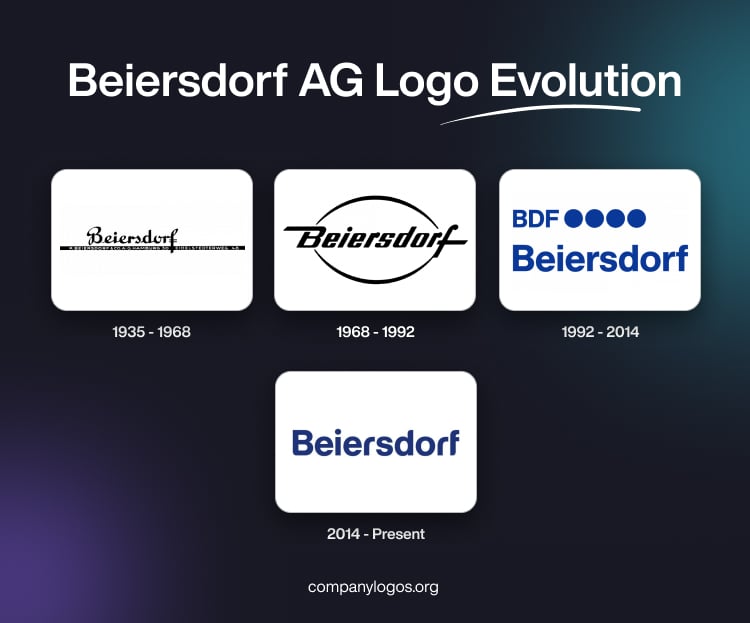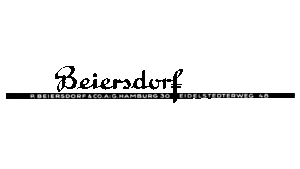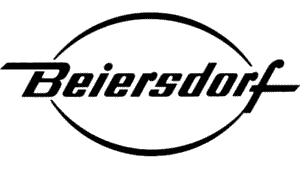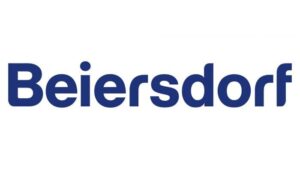
Beiersdorf AG is a German multinational consumer goods conglomerate dealing in personal care, skincare, and adhesive products. Owner of popular brands such as Nivea, Hansaplast, La Prairie, and Eucerin, Beiersdorf AG was founded in 1882 by Paul C. Beiersdorf. The logo of the company has evolved over the years and represents the journey of the brand in terms of achieving innovation, quality control, and catering to consumer preferences. The article explores the various logo changes of the brand since it came into existence.
The Genesis of the Beiersdorf AG Logo (1935 – 1968)
The original logo consisted of the brand name written in style by hand. The word “Beiersdorf” was placed above a long thick black stripe, which contained two wordmarks, namely, “P. BEIERSDORF & CO. A: G. HAMBURG 30” and “EIDELSTEDTS RWEG 48”.

(1968 – 1992)
In the 1968 logo variant, the brand name was placed within two arc-shaped thick black lines at the top and bottom. The edges of the lines touch the uppercase letter “B” at the beginning and the lowercase letter “f” at the end. Interestingly, both these letters had extended bars.

(1992 – 2014)
The 1992 variant featured the abbreviation “BDF” followed by four large dots in blue. Beneath these elements was placed the full name of the company, also in blue.

(2014 – Present)
The current logo was conceived in 2014, and it did away with the abbreviation and the four dots. The logo comprised the brand name “Beiersdorf” in a Helvetica Neue Heavy sans-serif typeface with rounded edges in blue.

The Elements of the Beiersdorf AG Logo
Font
The Beiersdorf AG logo uses a Helvetica Neue Heavy sans-serif typeface.
Colour
The Beiersdorf AG logo uses a minimalist colour palette of blue and white.
The History of Beiersdorf AG
The origin of Beiersdorf AG dates back to 1882, when pharmacist Paul C. Beiersdorf established a laboratory in Hamburg. The foundation of the company is marked by the patent obtained by Beiersdorf for the manufacture of coated medical plasters. In 1890, Dr Oscar Troplowitz acquired the company from Paul C. Beiersdorf and quickly transformed it into a leading branded goods manufacturer. It was Troplowitz who expanded operations, built a new factory in Hamburg-Eimsbüttel (still the company’s headquarters), and fostered scientific collaboration with dermatologist Paul Gerson Unna and chemist Isaac Lifschütz.
These partnerships led to the development of Eucerit, an emulsifier that became the key ingredient in NIVEA Creme. The company’s first major international contract was signed in 1893 with the US trading company Lehn & Fink. The company grew rapidly and expanded its product range to include shaving creams and shampoos in the 1930s. In 1922, following the deaths of Troplowitz and his partner Otto Hanns Mankiewicz, Beiersdorf transitioned into a public limited company (AG).
By the 1930s, Beiersdorf operated more than 20 production sites worldwide and was listed on the Hamburg Stock Exchange. The 1930s also saw the introduction of tesa, an umbrella brand for self-adhesive technology. Despite challenges during the Nazi era, the company continued to innovate and expand its product lines. After the Second World War, Beiersdorf established its market leadership in personal care and medical products. The 1960s and 1970s brought further growth, with new pharmaceuticals, industrial tapes, and continued dominance of brands like NIVEA, tesa, and Hansaplast in Europe.
Beiersdorf continued to innovate and expand globally throughout the late 20th and early 21st centuries. Today, the company operates in over 150 countries and boasts a diverse portfolio that includes world-renowned brands such as NIVEA, Eucerin, La Prairie, Labello, Hansaplast, and tesa. Beiersdorf remains based in Hamburg and is recognised for its commitment to research, quality, and consumer-focused solutions. It maintains its status as a global leader in skincare and personal care products.
Interesting Facts About Beiersdorf AG
- The company was founded in 1882 by Paul C. Beiersdorf in Hamburg. It began with a patent for coated medical plasters, which eventually laid the foundation for its future success.
- Oscar Troplowitz acquired the company in 1890 and transformed it into a global branded goods manufacturer.
- NIVEA Creme was launched in 1911 and was developed using the emulsifier Eucerit. Invented by chemist Isaac Lifschütz, Eucerit is derived from lanolin (sheep’s wool fat). This enabled the first stable oil-and-water-based cream suitable for mass production.
- The name “NIVEA” comes from the Latin word for “snow white” (nix, nivis). It reflects the pure white appearance of the cream.
- Labello, introduced in 1909, was the world’s first lip care stick packaged in a sliding tube. The name Labello means “beautiful lip” in Latin.
- By 1918, Beiersdorf had grown from just 11 employees to about 500 employees.
- In 1922, Beiersdorf became a public limited company (AG) and launched Hansaplast, a brand for adhesive wound plasters that remains well-known today.
- The iconic blue-and-white NIVEA tin design was introduced in 1925 and has remained largely unchanged. It has become one of the most recognisable packaging designs worldwide.
- By the 1930s, Beiersdorf had production plants in 23 countries and representative offices worldwide.
- The company introduced tesa in 1936 as an umbrella brand for self-adhesive products, which began with transparent adhesive film.
- During the Nazi regime, Jewish board members were forced to resign, and the company faced significant challenges. These include the loss of some international subsidiaries and trademark rights after the Second World War.
- Beiersdorf launched the 8×4 deodorant brand in 1951, which marked its expansion into personal hygiene products.
- By the 1970s, Beiersdorf employed over 10,000 people worldwide and restructured into divisions that focused on cosmetics, medical products, pharmaceuticals, and adhesive technology (tesa).
- In the 1990s, Beiersdorf repurchased many of its lost trademark rights, especially in countries like Great Britain, Australia, and South Africa.
- Today, Beiersdorf operates in over 150 countries and continues to be a leader in skincare and adhesive technology. It has flagship brands, such as NIVEA, Eucerin, La Prairie, Hansaplast, Labello, and tesa.
Finally
The Beiersdorf AG logo and its variants over the years show the transformation of the company from a small pharmacy laboratory to a global leader in personal care and medical products. Its logo was rooted in medical symbolism and then evolved to the modern, division-representing corporate design. The Beiersdorf logos have reflected both its heritage and its forward-looking vision. The enduring NIVEA logo stands as a testament to the power of consistent branding in building global trust and recognition.